
Mayfair is an area in London, England and is located in the City of Westminster. It is in Central London and part of the West End. It is between Oxford Street, Regent Street, Piccadilly and Park Lane and one of the most expensive districts in the world.
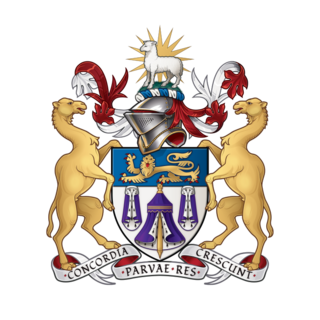
The Worshipful Company of Merchant Taylors is one of the 111 livery companies of the City of London.

Savile Row is a street in Mayfair, central London. Known principally for its traditional bespoke tailoring for men, the street has had a varied history that has included accommodating the headquarters of the Royal Geographical Society at 1 Savile Row, where significant British explorations to Africa and the South Pole were planned; and more recently, the Apple office of the Beatles at 3 Savile Row, where the band's final live performance was held on the roof of the building.

Burlington House is a building on Piccadilly in Mayfair, London. It was originally a private English Baroque and then Neo-Palladian mansion owned by the Earls of Burlington. It was significantly expanded in the mid-19th century after being purchased by the British government. Today, the Royal Academy and five learned societies occupy much of the building.

Brook Street is an axial street in the exclusive central London district of Mayfair. Most of it is leasehold, paying ground rent to and seeking lease renewals from the reversioner, that since before 1800, has been the Grosvenor Estate. Named after the Tyburn that it crossed, it was developed in the first half of the 18th century and runs from Hanover Square to Grosvenor Square. The western continuation is called Upper Brook Street; its west end faces Brook Street Gate of Hyde Park. Both sections consisted of neo-classical terraced houses, mostly built to individual designs. Some of them were very ornate, finely stuccoed and tall-ceilinged, designed by well known architects for wealthy tenants, especially near Grosvenor Square, others exposed good quality brickwork or bore fewer expensive window openings and embellishments. Some of both types survive. Others have been replaced by buildings from later periods.

Wigmore Street is a street in the City of Westminster, in the West End of London. The street runs for about 600 yards parallel and to the north of Oxford Street between Portman Square to the west and Cavendish Square to the east. It is named after the village of Wigmore and its castle in Herefordshire, a seat of the family of Robert Harley, politician around the time of Queen Anne, who owned land in the area.

Cork Street is a street in Mayfair in the West End of London, England, with many contemporary art galleries, and was previously associated with the tailoring industry.
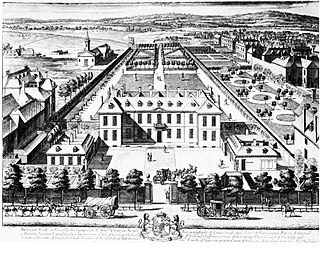
The Burlington Estate is an area in Mayfair to the north of Piccadilly in the West End of London, England. It was developed in the 18th century and owned by the Anglo-Irish Boyle dynasty, Earls of Burlington, in particular Richard, 3rd Earl of Burlington and 4th Earl of Cork (1694–1753).
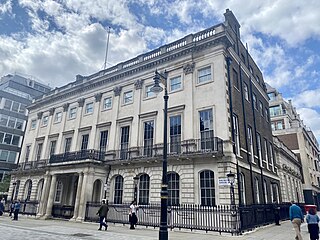
7 Burlington Gardens is a Grade II* building in Mayfair, London. Formerly known as Queensberry House, it was later called Uxbridge House. The building was a bank for much of the 19th and 20th centuries, and was later for a time home to the London flagship store of the American fashion retailer Abercrombie & Fitch.
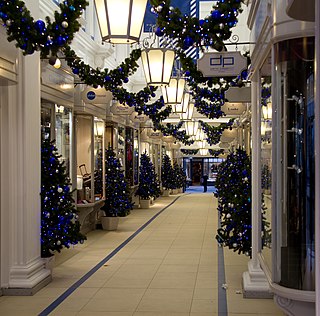
Princes Arcade is an arcade of shops running between Piccadilly and Jermyn Street in central London. It is home to a number of small menswear shops and boutiques.

Fortress House was a building with its main entrance at 23 Savile Row in London W1, also including 5–9 New Burlington Street. It was built in 1949–50 to a design by Anthony Lloyd, and demolished in 2009.

Burlington Gardens is a street in central London, on land that was once part of the Burlington Estate.

Vigo Street is a short street in central London that is named after the Anglo-Dutch naval victory over the French and Spanish in the 1702 Battle of Vigo Bay. It has important literary connections.
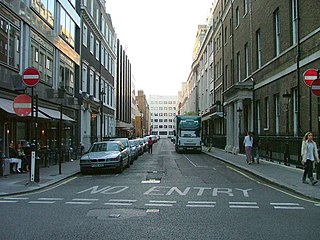
Old Burlington Street is a street in central London that is on land that was once part of the Burlington Estate.
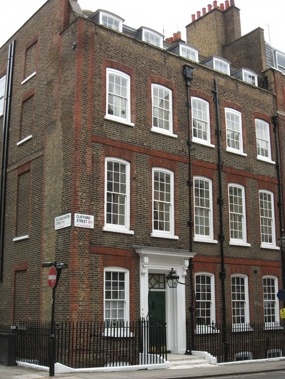
Clifford Street is a street in central London, built in the early 18th century, on land that once formed part of the Burlington Estate. It is named after the Clifford family, Earls of Cumberland. The daughter and heiress of the last holder of that title was the mother of the first Lord Burlington.
The West End Central Police Station was a police station at 27 Savile Row, in London's West End, on the junction with Boyle Street. It was the headquarters of the 'C' division of the Metropolitan Police, station-code 'CD' covering the City of Westminster.

New Burlington Street is a street in central London that is on land that was once part of the Burlington Estate. The current architecture of the street bears little resemblance to the original design of the street when first built in the early eighteenth century.
George Squibb was a British auctioneer, succeeding his father James, who founded the auction house of Squibb & Son, and working from public rooms in Boyle Street, facing down Savile Row, London, where the elder Squibb had set up in 1778. The grand rooms had been built in the 1730s, at the time Lord Burlington was developing the second phase of his real estate venture at the end of Burlington House gardens; they were extended by Squibb with a top-lit auction room. In 1813 he sold the collection of paintings of the late Duke of San Pietro. Among the country house auctions that fell under his hammer was that of the contents of Streatham Park, sold for Hester Thrale Piozzi in May 1816. Among those associated with Squibb was Michael Bryan, the connoisseur and author of the Dictionary of Painters
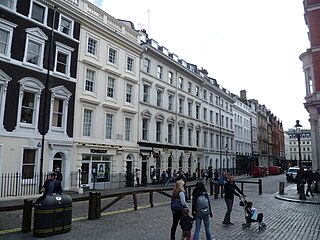
Henrietta Street is a street in Covent Garden, London, that was once home to a number of artists and later became the location of many publishing firms.
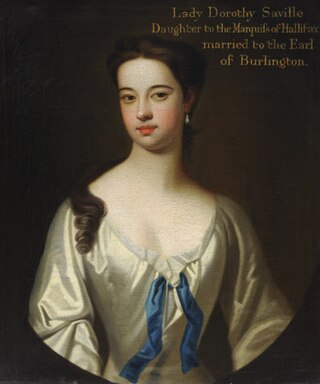
Dorothy Boyle, Countess of Burlington and Countess of Cork was a British noble and court official, as well as a caricaturist and portrait painter. Several of her studies and paintings were made of her daughters. Through her daughter Charlotte, who married the 4th Duke of Devonshire. A collection of 24 of her works of art descended to the Duke of Devonshire and kept at Chatsworth House.

















